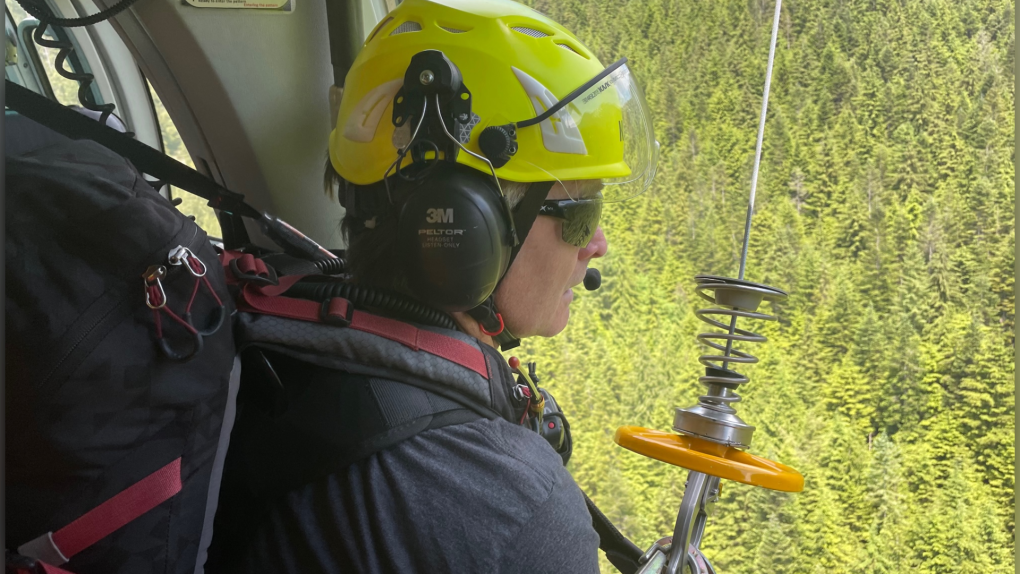Coquitlam SAR perform first rescue using new equipment
 Crews in Coquitlam were able to rescue a badly injured hiker on Saturday, July 2 2022. Image credit: Coquitlam SAR.
Crews in Coquitlam were able to rescue a badly injured hiker on Saturday, July 2 2022. Image credit: Coquitlam SAR.
A badly injured hiker was hoisted to safety in Coquitlam over the weekend in a first-of-its-kind helicopter rescue for local crews.
On Saturday around noon, SAR members were called to Widgeon Lake in Pinecone Burke Provincial Park.
Al Hurley was the team leader for the rescue and says early reports were that a woman had a serious leg injury.
"It was a fairly serious medical call," he says. "The terrain is really steep. Lots of slippery logs, lots of water running so it's easy to have a slip and fall like she did and it was pretty gnarly where she was. The area is very steep with really thick timber, so spotting her air from the air was next to impossible."
After pinging the woman's cellphone and doing a ground search of the area, they saw the woman's husband waving for help. Another team member was lowered down to assess the woman's injuries and found she had broken her knee.
"She was amazingly composed, she winced a few times as we were moving her to put her into the rescue bag," he continues. "She handled it like a trouper."
Hurley says the rescue was different than the typical long-line rescue, with crews using a winch machine for the first time since being trained on how to do so. Hurley explains that in a long-line rescue, the SAR member is basically attached to a rope that is hanging from the helicopter.
"That's how we fly. We're always on the end of the rope, until we get to the rescue site," he says, adding the line can be anywhere from 150 to 300 metres long and often needs to be adjusted. In this kind of rescue, the helicopter lands nearby where SAR members and whoever they have rescued get on board.
In a rescue using a winch, everyone stays inside the helicopter until it arrives at the rescue site. Then, members are lowered down while the helicopter hovers overhead. Once the situation has been assessed and the person being rescued is ready to go, everyone gets hoisted back up.
"It was definitely a time saver for us to get on the winch and then to be able to hover right above our spot and pluck all three of us out," he says of the inaugural use of the winch technology.
CTVNews.ca Top Stories

BREAKING Police to announce arrests in Toronto Pearson airport gold heist
Police say that arrests have been made in connection with a $20-million gold heist at Toronto Pearson International Airport one year ago.
Outdated cancer screening guidelines jeopardizing early detection, doctors say
A group of doctors say Canadian cancer screening guidelines set by a national task force are out-of-date and putting people at risk because their cancers aren't detected early enough.
Lululemon unveils first summer kit for Canada's Olympic and Paralympic teams
Lululemon says it is combining function and fashion in its first-ever summer kit for Canada's Olympians and Paralympians.
Canada's health-care crisis was 'decades in the making,' says CMA
The strain placed on Canadian health care during the COVID-19 pandemic shows no sign of abating, and the top official of the Canadian Medical Association (CMA) is warning that improving the system will be a 'slow process' requiring sustained investment.
'I just started crying': Blue Jays player signs jersey for man in hospital
An Ontario woman says she never expected to be gifted a Blue Jays jersey for her ailing husband when she sat alone at the team’s home opener next to a couple of kind strangers.
Mussolini's wartime bunker opens to the public in Rome
After its last closure in 2021, it has now reopened for guided tours of the air raid shelter and the bunker. The complex now includes a multimedia exhibition about Rome during World War II, air raid systems for civilians, and the series of 51 Allied bombings that pummeled the city between July 1943 and May 1944.
LIVE @ 4 EDT Freeland to present 2024 federal budget, promising billions in new spending
Canadians will learn Tuesday the entirety of the federal Liberal government's new spending plans, and how they intend to pay for them, when Deputy Prime Minister and Finance Minister Chrystia Freeland tables the 2024 federal budget.
B.C. woman facing steep medical bills, uncertain future after Thailand crash
The family of a Victoria, B.C., woman who was seriously injured in an accident in Thailand is pleading for help as medical bills pile up.
Step inside 'The Brain': Northern education tool aims to promote drug safety
An immersive experience inside a massive dome coined 'The Brain' is helping youth learn about brain function and addiction






























